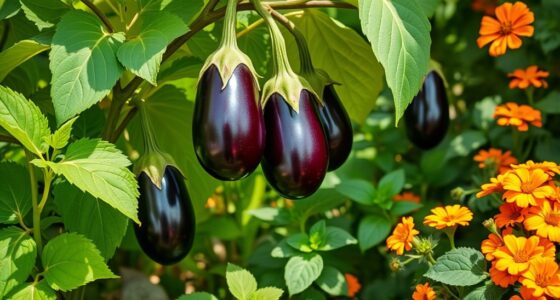Imagine stepping into your garden, greeted by vibrant colors and the distinct aroma of fresh herbs and vegetables. Among the rows of leafy greens, your pepper plants stand tall and proud, promising a burst of heat and flavor in every bite. But did you know that the journey to a thriving pepper garden goes beyond just your beloved peppers? By introducing the right pepper companion plants, you can transform a modest harvest into a flavorful explosion. Through careful selection and strategic planting, you can create a symbiotic environment that enriches not only your peppers but the entire garden ecosystem. This article will guide you through the best companion plants for peppers, ensuring you enjoy a bountiful and harmonious backyard.
Key Takeaways
- Companion planting enhances growth and health of pepper plants.
- Basil, tomatoes, onions, and marigolds are some of the best companion plants for peppers.
- Growing the right companions can improve flavor and protect against pests.
- Create a thriving garden ecosystem through strategic plant pairings.
- Experimenting with different combinations can lead to a richer harvest.
Why Companion Planting Matters for Peppers
Understanding the concept of companion planting can transform your pepper garden into a thriving ecosystem. Utilizing a companion planting guide for peppers allows you to create beneficial relationships between plants, leading to enhanced growth and flavor. This practice encourages the attraction of beneficial insects, while also providing natural pest control methods that reduce the need for chemical treatments.
Understanding the Benefits of Companion Plants
Companion plants offer numerous advantages. They can improve soil fertility and deter harmful pests. For example, planting flowers alongside your peppers enhances their well-being and provides essential nutrients from the soil. Such combinations foster a healthier environment, promoting robust pepper plants and a more bountiful harvest.
Enhancing Flavor and Growth
Many companion plants are known for enhancing flavor of peppers. For instance, basil not only pairs well with peppers in the kitchen but also improves their growth when planted together. These plants enrich the soil while encouraging the healthy development of your peppers, ensuring you enjoy a flavorful yield.
Natural Pest Control through Companion Planting
The role of natural pest control in companion planting cannot be overstated. Certain plants effectively repel pests that threaten peppers. This strategy promotes an organic growing environment and supports a balance in the garden ecosystem. You can enjoy a plentiful harvest without relying on harmful pesticides.
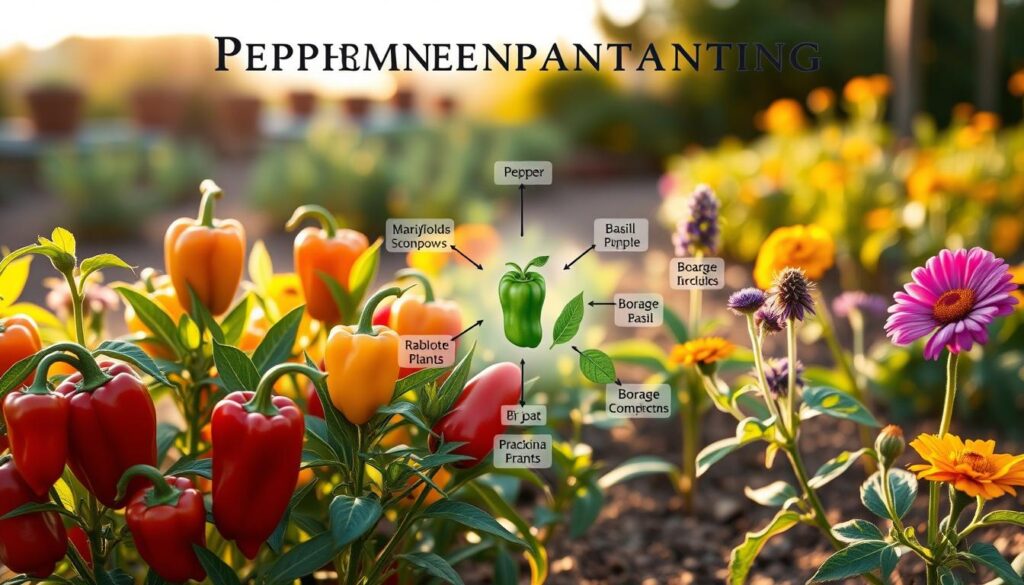
Top 10 Pepper Companion Plants
Choosing the right companion plants can significantly enhance your pepper garden. The best companion plants for peppers not only improve growth and flavor but also offer natural pest control benefits. Here are the top pepper plant companions you should consider for a thriving garden.
1. Basil: The Perfect Flavor Partner
Basil stands out as one of the best companion plants for peppers. Its aromatic leaves not only enhance the flavor of peppers but also deter pests such as aphids and spider mites. The presence of basil can create a delightful synergy between these plants.
2. Tomatoes: A Dynamic Duo in the Garden
Tomatoes serve as another top pepper plant companion due to their similar growing conditions. Both plants thrive in warm weather and appreciate good sunlight. Planting them together can result in healthier crops and an increased bounty.
3. Onions: Natural Pest Deterrents
Onions provide unique benefits, acting as a natural pest deterrent. Their strong aroma confuses pests, keeping them away from your valuable pepper plants. Additionally, onions do not compete for the nutrients needed by peppers, making them a perfect neighbor in the garden.
4. Marigolds: Bright Flowers, Fewer Pests
Marigolds are a colorful addition to any garden, but they do much more than just beautify the space. They attract beneficial insects while repelling harmful pests, such as nematodes. Integrating marigolds into your pepper planting strategy can lead to healthier plants and better yields.
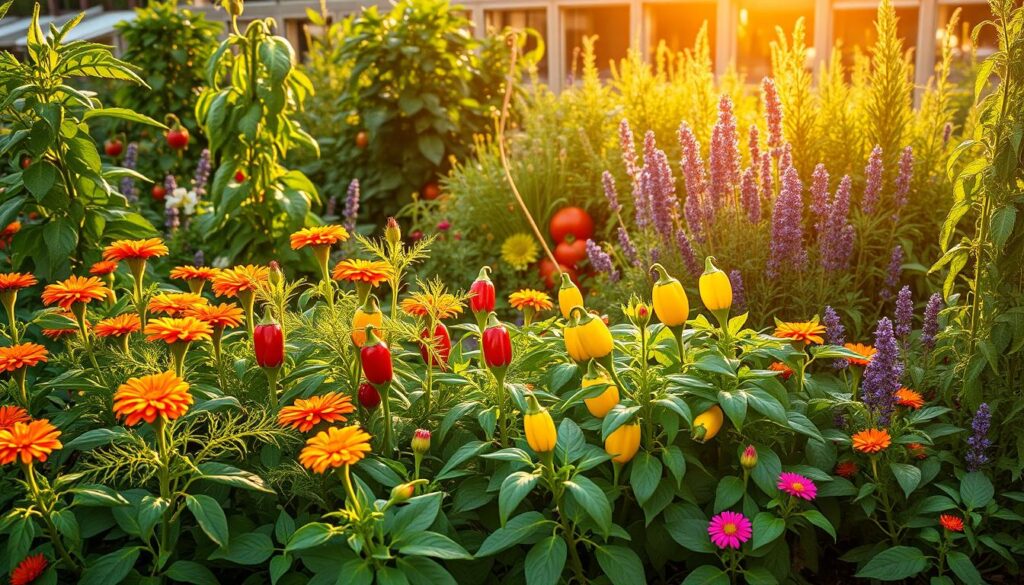
How Basil Enhances Pepper Growth
Basil serves as an exceptional companion plant for peppers, contributing to both their flavor and resilience. The strong scent of basil not only elevates the taste of the peppers you grow but also plays a critical role in protecting them from pests. This harmonious relationship allows your garden to thrive.
Boosting Flavor Profiles
Incorporating basil into your garden can significantly enhance the flavor of peppers. This aromatic herb elevates the taste, resulting in a more delicious harvest. When grown alongside peppers, basil infuses the air with its scent, creating an environment that improves the overall flavor profile of your crops.
Repelling Harmful Insects
Basil’s distinct aroma acts as a powerful deterrent against common garden pests, like aphids. By choosing basil as a companion plant, you create a natural barrier that helps protect your peppers from these harmful insects. This pest-repelling quality keeps your pepper plants healthier and more productive, ensuring a bountiful harvest.

Utilizing Tomatoes alongside Peppers
In your garden, you can take advantage of the synergy between tomatoes and peppers. These two crops not only share similar pepper growing conditions, but they also enhance each other’s growth and overall health. Knowing how to make the most of this relationship can lead to a thriving garden.
Shared Growing Conditions
Both tomatoes and peppers enjoy full sun and warm weather, making them perfect companions. They thrive in similar soil types, preferring well-drained, nutrient-rich environments. Planting tomatoes as companion plants for peppers allows you to optimize space while ensuring both species receive the sunlight and moisture they require.
Benefits for Soil Health
One of the essential advantages of integrating tomatoes and peppers is the improvement of soil health. The root systems of tomatoes penetrate deeply into the ground, aerating the soil and making nutrients more accessible for pepper plants. This benefits their growth, resulting in healthier and more productive plants in your garden.

| Aspect | Tomatoes | Peppers |
|---|---|---|
| Sunlight Requirement | Full sun | Full sun |
| Soil Type | Well-drained, nutrient-rich | Well-drained, nutrient-rich |
| Watering Frequency | Moderate | Moderate |
| Companion Planting Advantage | Enhances soil aeration | Benefits from nutrient accessibility |
The Role of Onions in Pepper Gardens
Onions serve as excellent companions for your pepper plants, bringing numerous advantages to your garden. Incorporating onions as pepper companions can create a dynamic environment that promotes healthy growth while naturally deterring pests. Their strong scent is a key factor in protecting your pepper plants from various unwanted invaders.
Companion Planting Techniques
When using onions alongside peppers, consider implementing companion planting techniques that maximize the benefits of these two plants. You can plant onions in close proximity to your peppers, allowing their natural pest deterrents to ward off common pests. This method not only enhances pest control but also optimizes space in your garden.
Protective Qualities of Onions
The protective qualities of onions play a crucial role in maintaining the health of your pepper plants. Onions can successfully deter aphids, cabbage worms, and a variety of other garden pests due to their strong aroma. As you plant onions near your peppers, you’ll provide an additional layer of protection without hindering the nutrient uptake necessary for robust growth.

Utilizing onions as pepper companions not only boosts the resilience of your garden but also contributes to a thriving ecosystem, making your gardening experience more enjoyable and productive.
Marigolds: Colorful Allies in the Garden
Incorporating marigolds as companion plants in your garden offers a vibrant splash of color while providing significant benefits to your pepper plants. These cheerful blooms are a gardener’s ally, attracting beneficial insects and enhancing soil quality.
How Marigolds Attract Beneficial Insects
Marigolds naturally draw in helpful insects like ladybugs and lacewings. These beneficial allies play a crucial role in keeping pest populations, such as aphids and spider mites, under control. By placing marigolds strategically among your pepper plants, you can create a healthier ecosystem that promotes growth and vitality.
Improved Soil Conditions with Marigolds
One of the key aspects of improving soil health with marigolds involves their root systems. These flowers release compounds that help combat nematodes, pests that can harm root systems. This natural defense mechanism of marigolds supports your peppers by enhancing soil health and promoting robust root development.

| Benefit | Description |
|---|---|
| Attracts Beneficial Insects | Helps control pest populations, promoting a balanced ecosystem. |
| Soil Health Improvement | Releases compounds to fight nematodes, fostering healthier plant roots. |
| Aesthetic Appeal | Adds vibrant colors to your garden, enhancing its visual appeal. |
Embracing marigolds as companion plants will undoubtedly elevate both the health of your garden and the beauty of your space. They invite beneficial insects while simultaneously working to enrich the soil.
Other Notable Pepper Companion Plants
When considering other companion plants for peppers, you can enhance your garden’s yield while maximizing garden resources. A few lesser-known plants provide unique benefits alongside your favorite peppers. Here are some excellent options to consider:
5. Carrots: A Great Soil Companion
Carrots serve as beneficial companions for peppers due to their ability to break up compact soil. This improves root penetration, allowing moisture to access deeper layers, which is vital for both carrots and peppers. Their growth supports overall soil health in your garden.
6. Beans: Nitrogen Fixers for Peppers
Beans play an essential role as nitrogen fixers in the garden. By converting nitrogen from the air into a form that plants can utilize, they greatly benefit nitrogen-loving peppers. This natural fertilization contributes to robust pepper growth, ensuring a bountiful harvest.
7. Spinach: Maximizing Space and Resources
Spinach is a low-growing plant that excels at maximizing space in your garden. It benefits from the partial shade of taller pepper plants, which helps retain soil moisture. This relationship creates a harmonious environment that supports both crops, enabling efficient use of garden resources.
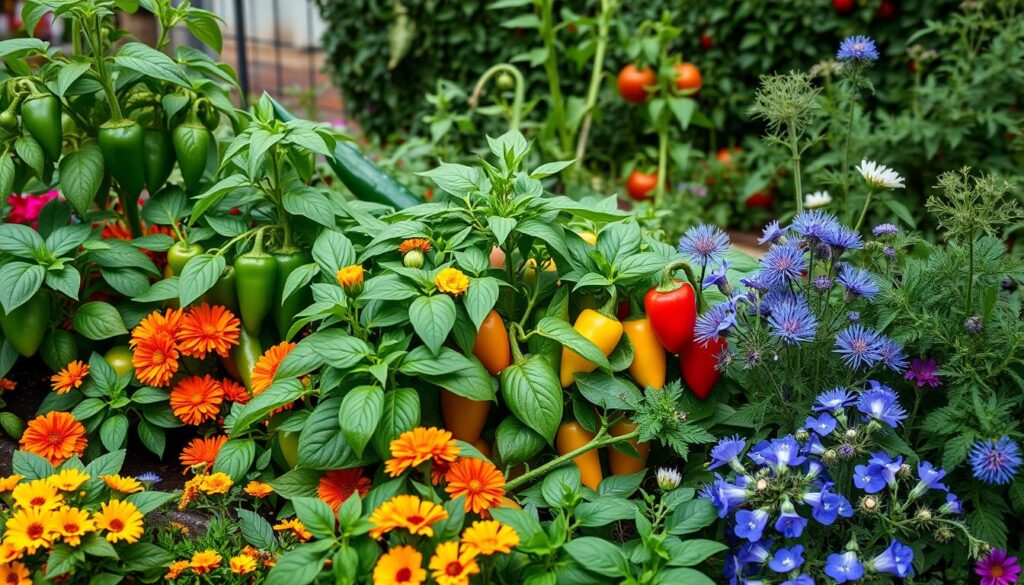
Growing Carrots with Peppers
Integrating carrots into your pepper garden offers incredible benefits, especially when it comes to optimizing garden space. Carrots thrive well under the shady foliage of pepper plants, allowing for an efficient use of your gardening area.
Space Utilization Strategies
When you plant carrots alongside peppers, you enhance the overall yield of your garden. Carrots grow downward while peppers spread out above, utilizing every inch of available ground. This strategic layering reduces wasted space and creates a more productive planting arrangement.
Root Development Benefits
Growing carrots with peppers has the added advantage of improving soil health through root development. Carrots’ long taproots help to aerate the soil, contributing to better water penetration and nutrient availability. This benefits the pepper plants, leading to healthier growth and potentially higher yields.

The Benefits of Growing Beans Near Peppers
Integrating beans into your pepper garden offers numerous advantages that can enhance your overall gardening success. Beans as nitrogen fixers for peppers play a vital role in improving soil quality, which directly influences the health and productivity of your pepper plants. This collaboration not only supports individual plant growth but also fosters a thriving ecosystem in your garden.
Boosting Soil Fertility
Beans contribute to soil fertility by converting atmospheric nitrogen into a form that plants can use. This process enriches the soil, providing essential nutrients that benefit peppers. As peppers thrive on these nutrients, they grow more robust and yield better harvests. The inclusion of beans in your garden can lead to more vigorous plants and a more rewarding gardening experience.
Symbiotic Relationships in the Garden
Using beans and peppers together exemplifies the best of symbiotic gardening practices. While the beans improve soil fertility, the peppers can offer structural support and shade, creating an ideal microenvironment. These two plants complement each other, enabling you to maximize your garden space and promote healthy plant interactions.
Overall, embracing beans as nitrogen fixers for peppers can transform your gardening approach, leading to healthier plants and bountiful harvests.
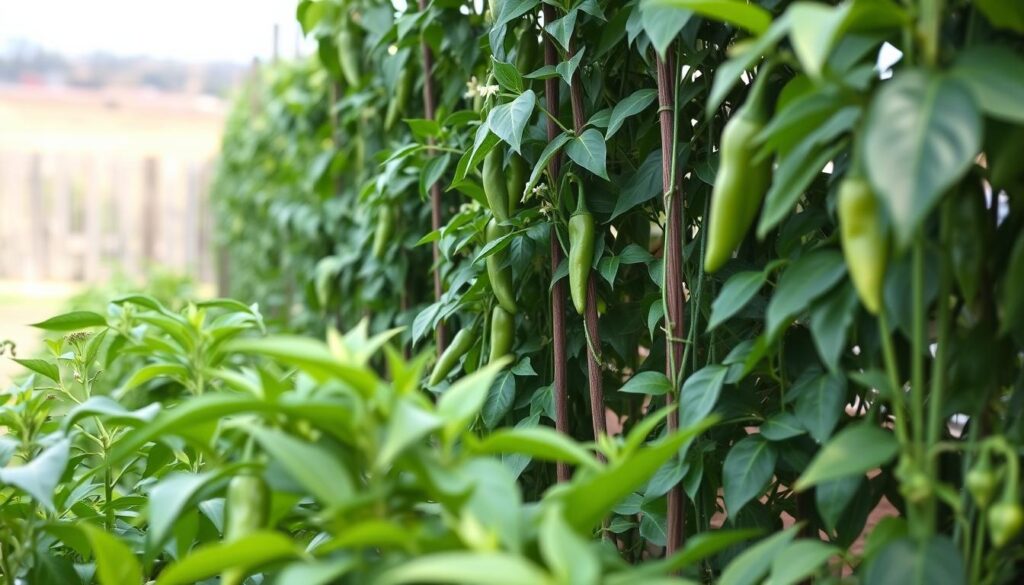
Pairing Spinach with Your Peppers
Integrating spinach as a companion plant for peppers creates an efficient garden setup. This leafy green grows close to the ground, allowing you to maximize vertical space in your garden. By positioning it beneath taller pepper plants, you optimize available sunlight and keep the soil temperature regulated.
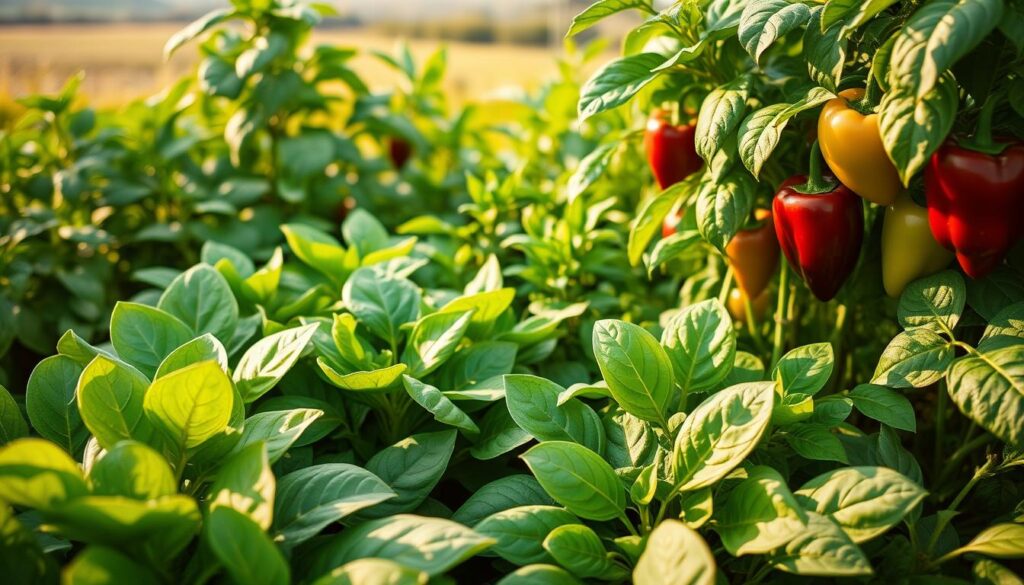
Maximizing Vertical Space
When you plant spinach alongside your peppers, you take advantage of vertical growing opportunities. Spinach does not overshadow pepper plants, making it an excellent choice for gardeners aiming to utilize every inch of their garden beds. This arrangement promotes healthy growth and aids in conserving moisture, an important factor during warmer seasons.
Companionship for Optimal Growth
The relationship between spinach and peppers goes beyond space efficiency. Spinach can help retain soil moisture while also providing a cool environment for the roots of pepper plants. This cooperation enhances the overall health of both plants, contributing to maximizing garden yield. A well-planned pairing can lead to flourishing pepper plants with improved harvests, demonstrating the effectiveness of strategic companion planting.
Avoiding Poor Companion Choices
When cultivating peppers, being mindful of the plants you choose to surround them with is crucial. Some plants can adversely affect the growth and health of your pepper plants, making it essential to recognize harmful companion plants for peppers. By avoiding specific plants, you can foster a thriving garden.
Plants to Keep Away from Peppers
- Cabbage
- Kale
- Fennel
Identifying Harmful Companions
Members of the brassica family, such as cabbage and kale, produce chemicals that can inhibit the growth of peppers, presenting significant harmful companion plants for peppers. Fennel is another concern, as it competes for nutrients essential for your peppers, potentially resulting in stunted growth. Understanding these plants to avoid in pepper gardens can lead to more productive and healthy plants.

Best Practices for Companion Planting
Effective companion planting enhances your pepper garden by ensuring that each plant thrives alongside its neighbors. Embracing the best practices for companion planting can significantly impact your garden’s health and productivity. When selecting companion plants, consider their growth habits, nutrient needs, and how they interact with one another. Implementing these companion planting tips and tricks will lead to a flourishing garden.
Tips for Successful Companion Combinations
- Maintain spacing of 12 to 18 inches between pepper plants for optimal airflow.
- Choose companions that share similar growing conditions to support each other.
- Rotate crops each season to minimize soil depletion and pest buildup.
Soil and Sunlight Considerations
Understanding soil quality and sunlight availability is crucial for successful planting. Peppers thrive in full sun, requiring six to eight hours of direct light daily. Select companion plants that do not shade your peppers or compete for essential resources. Additionally, enrich the soil with organic matter to improve nutrient availability, supporting both your pepper plants and their companions.
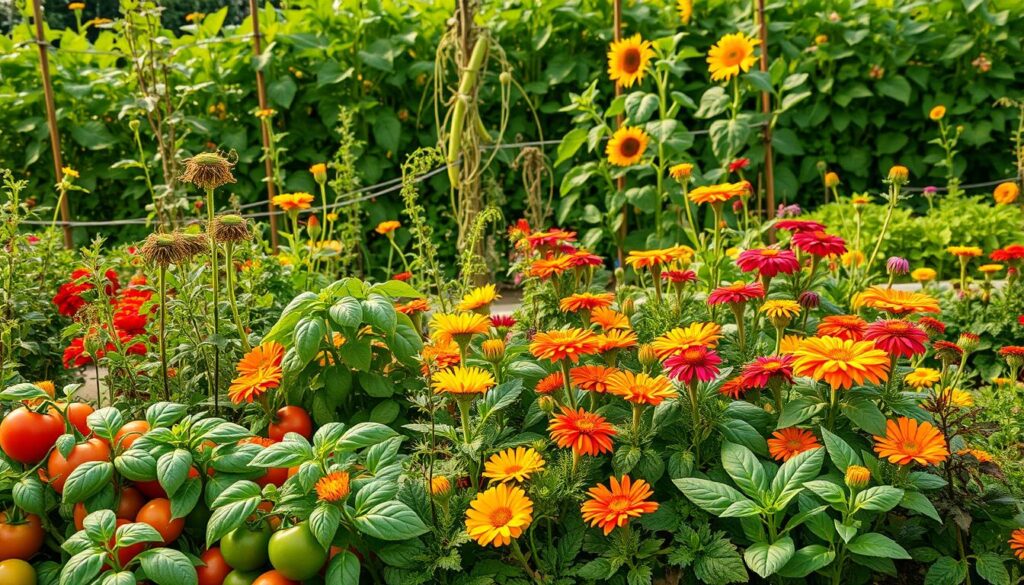
Seasonal Planting Strategies for Peppers
Successful pepper gardening relies on effective seasonal planting strategies for peppers. Timing is a crucial element that can significantly influence the health and productivity of your pepper plants and their companions. By aligning planting schedules with the growth stages of both peppers and companion plants, you can foster an optimal growing environment.
Timing Your Companion Planting
It’s essential to understand the specific requirements of each companion plant when considering timing. For instance, certain companions thrive when planted early in the season, which can enhance the overall growth of peppers later. Planting companions like basil alongside peppers can create a strong foundation for growth, as their needs often coincide. Regularly monitoring temperatures and soil conditions will help you in effectively planning your planting schedule.
Seasonal Variations and Adjustments
Adaptability is key when implementing seasonal planting strategies for peppers. Seasonal variations may require adjustments, such as changing the types of companion plants used or their planting depth. Some plants may need to be sown earlier to combat pests effectively, while others might flourish if planted just before the main pepper crop takes root. Keeping abreast of local climate conditions can further guide your decisions on the timing of companion plants, ensuring a harmonious garden dynamic.
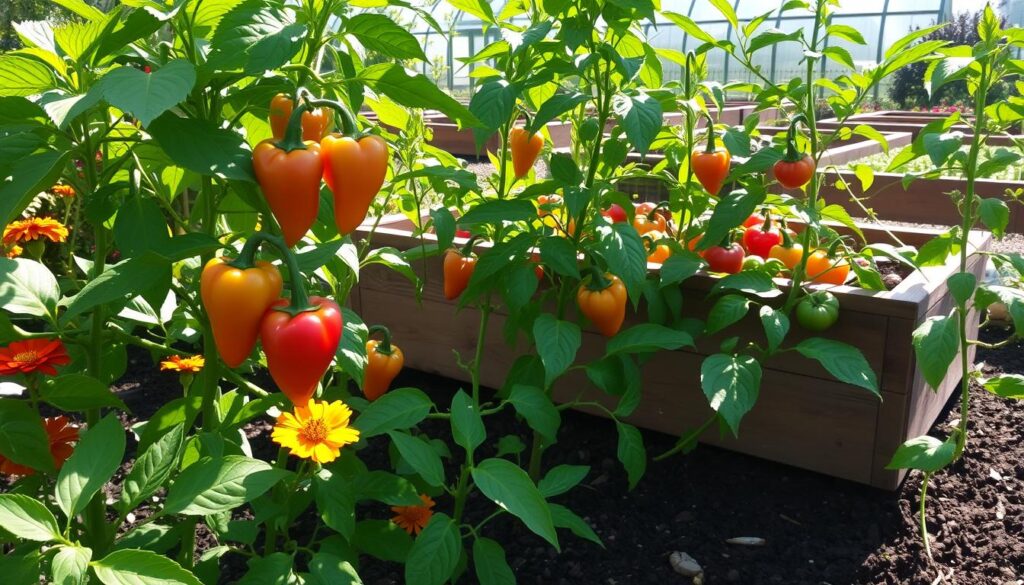
Conclusion: Enhancing Your Pepper Garden
Understanding the nuances of companion planting can transform your gardening experience. By integrating various plant species that benefit each other, you open up pathways to a healthier and more productive pepper garden. The benefits of companion planting include improved flavors, increased pest resistance, and overall growth. Each companion plays a specific role, allowing your peppers not only to thrive but also to yield a more bountiful harvest.
Recap of Companion Benefits
As you reflect on the benefits of companion planting, consider how essential partners like basil, tomatoes, and marigolds contribute to the ecosystem of your garden. These plants provide natural pest control and enhance soil conditions, leading to a thriving environment where peppers can flourish. With the right combinations, your gardening efforts can yield results that go beyond your expectations.
Encouragement to Experiment and Explore
Don’t hesitate to explore different pairings of companion plants tailored to your specific needs. Gardening is a journey of discovery, and experimenting with various combinations can lead to better results. By understanding the interplay of different species, you can enjoy the full benefits of effective companion planting, ultimately enhancing your pepper garden. Embrace the opportunity to learn and adapt, ensuring a fruitful and enjoyable gardening season ahead.





